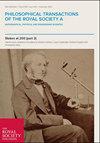Origin of short–lived radionuclides
Philosophical Transactions of the Royal Society of London. Series A, Mathematical and Physical Sciences
Pub Date : 2001-10-15
DOI:10.1098/rsta.2001.0893
引用次数: 41
Abstract
This paper reviews the evidence for short–lived radionuclides in the early Solar System and critically evaluates models for their origin. Radionuclides with half–lives of less than 50 Myr for which firm and consistent evidence has been found are 10Be, 26Al, 41Ca, 53Mn, 60Fe, 107Pd, 129I and 182Hf. The oldest Solar System objects, calcium–aluminium–rich inclusions (CAIs), contained 10Be, 26Al, 41Ca and 53Mn on formation. We discuss whether a spallation or stellar origin for the radionuclides is more likely, and conclude that the initial presence of short–lived radionuclides in CAIs can be most easily explained if these formed by spallation reactions close to the protosun.短寿命放射性核素的起源
本文回顾了早期太阳系中短寿命放射性核素的证据,并对其起源的模型进行了批判性评估。半衰期小于50myr的放射性核素有10Be、26Al、41Ca、53Mn、60Fe、107Pd、129I和182Hf。最古老的太阳系天体,富钙铝包裹体(CAIs),在形成时含有10Be, 26Al, 41Ca和53Mn。我们讨论了放射性核素更可能是散裂还是恒星起源,并得出结论,如果这些放射性核素是由靠近原太阳的散裂反应形成的,那么在cai中最初存在的短寿命放射性核素最容易解释。
本文章由计算机程序翻译,如有差异,请以英文原文为准。
求助全文
约1分钟内获得全文
求助全文
来源期刊
自引率
0.00%
发文量
0

 求助内容:
求助内容: 应助结果提醒方式:
应助结果提醒方式:


